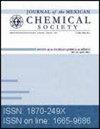Morphological and Nutritional Characterization of Wild Edible Blackberries (Rubus spp.) from Sinaloa, Mexico
IF 1.1
4区 化学
Q3 CHEMISTRY, MULTIDISCIPLINARY
引用次数: 0
Abstract
Abstract. Wild blackberries (Rubus) are fruits that grow in inaccessible high mountain areas, which has made it difficult to study their chemical and nutritional composition. The objective of this research was to evaluate the nutritional composition and the macro- and micro-nutrient profile of wild species of fruits of the Rubus genus collected in Sinaloa, Mexico. Botanical samples of wild Rubus were identified and deposited in the Herbarium of the Institute of Biology of the UNAM. Subsequently, the chemical composition the profile of carbohydrates, lipids and minerals were evaluated. Wild Rubus species were identified as R. liebmannii, R. coriifolius and R. palmeri. In addition, it was found that R. liebmannii is the first time it has been recorded for the state of Sinaloa. Likewise, the results show that carbohydrates represent the largest proportion of the macro-components (85 %, glucose and fructose); they have a high content of fatty acids (such as linolenic acid) and are rich sources of minerals (such as K, Ca and Mg). The results of this research could be relevant to be used in the genetic improvement of commercial species that currently exist in the market. Resumen. Las zarzamoras silvestres (Rubus) son frutos que se desarrollan en zonas de alta montaña poco accesibles, lo que ha dificultado el estudio de su composición química y nutricional. El objetivo de la presente investigación fue evaluar la composición nutricional y el perfil de macro y micronutrientes de especies silvestres de frutos del género Rubus colectadas en Sinaloa, México. Muestras botánicas de Rubus silvestres fueron identificadas y depositadas en el Herbario del Insituto de Biología de la UNAM. Posteriormente se les evaluó la composicón química, el perfil de perfil de carbohidratos, lípidos y minerales. Las especies silvestres de Rubus fueron identificadas como Rubus liebmannii, Rubus coriifolius y Rubus palmeri. Además, se encontró que Rubus liebmannii, es la primera vez que se registra para el estado de Sinaloa. Asimismo, los resultados muestran que los carbohidratos representan la mayor proporción de los macro-componentes (85 %, glucosa y fructosa); tiene un alto contenido de ácidos grasos (como ácido linolénico) y son fuentes ricas de minerales (como K, Ca y Mg). Los resultados de la presente investigación podrían ser de relevancia para ser utilizados en el mejoramiento genético de especies comerciales que actualmente existen en el mercado.墨西哥锡那罗亚野生食用黑莓(Rubus spp.)
摘要野生黑莓(Rubus)是生长在人迹罕至的高山地区的水果,因此很难对其化学和营养成分进行研究。本研究的目的是评估在墨西哥锡那罗亚采集的野生茜草属果实的营养成分以及宏观和微观营养成分概况。对野生茜草的植物样本进行了鉴定,并将其保存在墨西哥国立自治大学生物研究所的标本馆中。随后,对碳水化合物、脂类和矿物质的化学成分进行了评估。经鉴定,野生茜草物种为 R. liebmannii、R. coriifolius 和 R. palmeri。此外,还发现 R. liebmannii 是锡那罗亚州首次记录到的物种。同样,研究结果表明,碳水化合物在大分子成分中所占比例最大(85%,葡萄糖和果糖);脂肪酸(如亚麻酸)含量高,矿物质(如钾、钙和镁)来源丰富。这项研究的结果可用于市场上现有商业品种的遗传改良。摘要。茜草(Rubus)是一种在高山地区生长的水果,其生长环境十分恶劣,因此很难对其营养成分进行研究。本研究的目的是评估墨西哥锡那罗亚州采集的茜草科植物的营养成分和宏量与微量营养元素的含量。确定了茜草的植物群,并将其保存在墨西哥国立自治大学生物研究所的植物标本室。之后,对其成分、碳水化合物、鳞片和矿物质进行了评估。鉴定出的茜草品种有:Rubus liebmannii、Rubus coriifolius 和 Rubus palmeri。此外,我们还发现,Rubus liebmannii 是首次在锡那罗亚州登记。同样,研究结果表明,碳水化合物在大分子成分中所占比例最大(85%,葡萄糖和果糖);钙含量较高(如亚麻酸钙);矿物质含量丰富(如钾、钙和镁)。本研究的结果可能与市场上现有商业物种的基因改良有关。
本文章由计算机程序翻译,如有差异,请以英文原文为准。
求助全文
约1分钟内获得全文
求助全文
来源期刊
CiteScore
2.00
自引率
0.00%
发文量
0
审稿时长
6-12 weeks
期刊介绍:
The Journal of the Mexican Chemical Society (J. Mex. Chem. Soc.) is a scientific, blind, peer reviewed, and open access, free of charge publication that covers all areas of chemistry and its sub-disciplines (i.e. medicinal chemistry, natural products, electrochemistry, material science, computational chemistry, organic chemistry, bionirganic chemistry, etc). It is devoted to facilitating the worldwide advancement of our understanding of chemistry. It will primarily publish original contributions of research in all branches of the theory and practice of chemistry in its broadest context as well as critical reviews in active areas of chemical research where the author has published significant contribution. The J. Mex. Chem. Soc. is a quarterly publication which language of submission and publication is English. To be suitable for publication in J. Mex. Chem. Soc., manuscripts must describe novel aspects of chemistry, high quality of results and discussion an excellent bibliographic support, and contribute to the development of the field. Routine or incremental work are not suitable for publication in J. Mex. Chem. Soc. Authors are encouraged to send contributions in electronic form. Our online submission system guides you stepwise through the process of entering your article details and uploading your files.

 求助内容:
求助内容: 应助结果提醒方式:
应助结果提醒方式:


